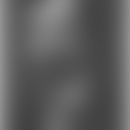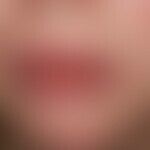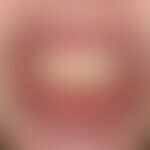Synonym(s)
HistoryThis section has been translated automatically.
Stevens and Johnson, 1922
DefinitionThis section has been translated automatically.
Acute clinical picture, usually characterized by febrile, respiratory prodromes and a general feeling of illness, which belongs to the disease group of non-autoimmunological, blistering severe skin reactions. 1-14 days after the onset of prodromia, erosive mucositis of varying severity occurs in at least two mucosal regions (e.g. conjunctiva/ oral mucosa). conjunctiva/ oral mucosa/ genital mucosa/ anal mucosa), as well as a mostly generalized, truncal disseminated exanthema with red, small (0.2-0.4 cm) to (due to confluence) large (>20 cm) spots and patches, on which subepithelial firm blisters and extensive skin detachments (exfoliations pushed together like a hand towel) can develop.
Targetoid (atypical cockades) erythema areas can be detected in places, but also other figural formations.
Note: As there are fluid transitions between SJS and toxic epidermal necrolysis(TEN) (SJS-TEN overlap), SJS is defined as a disease in which the skin detachment is < 10% of the KOF (around 60% of all patients with SJS belong to this group). Skin detachment between 10 and 30% is defined as a transitional form of SJS/TEN (SJS-TEN overlap) (25% of patients). Skin detachment > 30% is diagnosed as toxic epidermal necrolysis (TEN ) (15% of patients), a clinical picture that requires intensive care.
SJS, SJS/TEN and TEN have recently been recognized as an entity(epidermal necrolysis) with different expressivity and severity.
You might also be interested in
Occurrence/EpidemiologyThis section has been translated automatically.
The SJS and TEN are rare overall. The incidence in Germany is expected to be 1.8/1 million people/year in the USA with 1.9/1 million people/year. Additive risk factor is the HIV infection. The risk of contracting the disease is 1000 times higher than in the normal population.
EtiopathogenesisThis section has been translated automatically.
Stevens-Johnson syndrome (SJS) as well as toxic epidermal necrolysis (TEN ) are considered to be T-cell mediated reactions. Current data suggest that certain alleles of human leukocyte antigens (HLA: HLA-A 3101;HALA-B5801) are involved in the activation chain of CD8+ cytotoxic T cells and NK cells. CD8+ T lymphocytes make up the epidermal inflammatory infiltrate in the early phase of the disease. This leads to the release of cytokines that induce apotosis of keratinocytes. The cationic cytokine granulysin in the blister fluid correlates with the severity of the disease. Furthermore, the interaction of Fas and Fas ligands on epidermal keratinocytes plays a decisive role in the induction of apoptosis. Soluble FasL (see Fas ligand below) is detectable in the serum of patients with severe drug reactions (Hertel M 2018).
Triggers or co-triggers of SJS are (Creamer D et al. 2016):
- Medications: >75% (NSAIDs, in particular ibuprofen and naproxen, allopurinol, sulfonamides (the combination of trimethoprim/sulfmethoxazole is cited in various studies as the most common cause! The combination of trimethoprim/sulfmethoxazole is cited as the most frequent cause! (Micheletti RG et al. 2018), anticonvulsants (carbamazepine, phenytoin, phenobarbital, lamotrigine, valproic acid), penicillins, doxycycline, tetracycline, cephalosporins; tyrosine kinase inhibitors).
- Bacterial infections: <25% (mycoplasma, yersinia, chlamydia, various types of cocci)
- Viral infections: enteroviruses, adenoviruses, measles, mumps, influenza viruses, retroviruses (HIV). Infections are described as additive risk factors. HIV infections can increase the risk of SJS by a factor of 1000.
- Fungal infections, coccidia, histoplasmas
- Malignant tumors or irradiation situations
- Vaccinations(measles, mumps, rubella)
- Genetics: Clear association of HLA-B-1502 with carbamazepine-induced SJS. In allopurinol-induced SJS there is an increased association with HLA-B-5801
- Idiopathic
ManifestationThis section has been translated automatically.
In larger studies the mean age was around 50 years.
ClinicThis section has been translated automatically.
SJS is initially characterized by uncharacteristic, febrile, catarrhal prodromal symptoms, possibly with stomatitis, cheilitis, purulent rhinitis, purulent conjunctivitis, dysuria and a truncal, disseminated exanthema of varying severity, ranging from a few shooting-disc-like individual lesions (atypical cockades - see cockades below) to a large, scarlatiniform exanthema. Within 1-2 days, formation of large, flaccid, easily rupturing blisters all over the body (here, smooth transitions to toxic epidermal necrolysis can occur, see above). (see also under Epidermal necrolysis). Later drying of the blister covers and appearance of coarse lamellar desquamation. An important clinical-diagnostic finding is the positive Nikolski phenomenon, the displacement of the skin surface under tangential pressure! The following skin/mucous membrane regions are affected:
Lips (90% involvement) flat, firmly adherent hemorrhagic crusts appear.
Eyes (90% of cases): Purulent conjunctivitis
Genitals (70% involvement): Frequent involvement as painful, erosive vulvitis and balanitis (balanoposthitis).
Respiratory tract: 40% of patients develop acute pulmonary complications, 25-40% require mechanical ventilation therapy.
Joint involvement (arthritis) is rarer
Generalized lymphadenopathy and hepato-splenomegaly may also occur.
LaboratoryThis section has been translated automatically.
Increase in acute phase indicators (ESR, CRP, leukocytosis). Inconstantly present eosinophilia (20%), anemia (15%), increased liver enzymes (15%), proteinuria and hematuria (5%).
HistologyThis section has been translated automatically.
The histological picture of SJS corresponds to that of classical acute cytotoxic interface dermatitis with plexus-like (orthokeratotic) stratum corneum, pronounced intra- and subepidermal edema up to blistering. Later extensive epidermal necrosis. Mostly rather spindly lymphocytic infiltrate. Numerous dyskeratotic keratinocytes.
Differential diagnosisThis section has been translated automatically.
Complication(s)(associated diseasesThis section has been translated automatically.
TherapyThis section has been translated automatically.
Regular antiseptic wound treatment with antiseptic solutions or gels should be carried out to reduce the risk of infection. The antiseptics should be warmed. Solutions containing polihexanide and octenidine are recommended.
- In the case of minor skin detachment, the epidermis should be left in situ.
- If large blisters form, they should be relieved by puncture. The blister cover remains in situ.
- Careful removal of the detached skin should be considered in the case of extensive skin detachment.
If no systemic treatment with glucocorticoids is given, topical glucocorticoid externals can be applied for a maximum of 5 days (glucocorticoids class III/IV in adults and corticoids class III in children and adolescents). They should be applied to lesional but not yet eroded areas of skin.
For the treatment of eroded areas of the skin, they should be applied to non-stick, non-adherent silicone spacers or greasy gauze to cover the wound. Silver-containing topicals and wound dressings are also used in acute care (silver sulphadiazine). Limitations include an increased risk of absorption of silver-containing particles (monitoring of leukocytes, liver and kidney values) and, when using silver sulfadiazine, the possible causal triggering of toxic epidermolysis by sulfmethoxazole or sulfasalazine.
The frequency of topical antiseptic treatment is based on the frequency of dressing changes.
Topical antibiotics and antibiotic wound washes should be avoided.
Lip and oral mucosa involvement (frequent infestation): White kerosene or an ointment containing dexpanthenol should be applied to the erosive lip skin several times a day. Alternatively, white beeswax or a local anesthetic ointment would be indicated. Antiseptic mouthwashes should be carried out regularly. Rinsing with dexpanthenol or ointment solutions is also useful. Prophylactic administration of antibiotics or antiviral substances is not necessary.
Eye involvement (50-80% involvement): Preservative-free wetting agents should be used 1-2 hourly during the day to care for the ocular surfaces, regardless of severity. Ocular ointments should be used at night. If the ocular surface is intact, a preservative-free topical corticosteroid (e.g. 1% prednisolone) should be applied. If anti-inflammatory topical treatment is necessary for >2-4 weeks, a switch to topical calcineurin inhibitors(Ciclosporin A, Tacrolimus) is recommended.
Genital involvement (up to 70%): In patients with erosive involvement of the genital mucosa or dysuria, a urinary catheter (Foley catheter) should be inserted. Gentle cleansing of the urogenital area with sterile water and physiological saline solution. Basic protective care (e.g. white kerosene ointment) should be applied several times a day. Topical corticosteroids can be applied for a maximum duration of 5 days (glucocorticoids class III/IV in adults and corticoids class III in children and adolescents). They should be applied to lesional but not yet eroded areas of skin. Covering the lesions with non-adherent fat gauze is recommended.
If the female genitals are involved, vaginal stents/phantoms should be used to avoid synechiae. Menstrual suppression may be considered.
Anal region involvement: Antiseptic sitz baths e.g. with potassium permanganate (light pink) and glucocorticoid creams (see above). Administration of mild laxatives to soften the stool; if necessary, switch to a strained or liquid diet; parenteral nutrition if necessary.
Caution! Eye involvement: treatment by an ophthalmologist. Symblepharon formation is possible!
General therapyThis section has been translated automatically.
SJS is generally considered a serious illness that requires intensive medical care. In this respect, transfer to a surgical intensive care unit is recommended in order to guarantee continuous monitoring of vital parameters.
Regular antiseptic wound treatment with antiseptic solutions or gels should be carried out. For minor
Internal therapyThis section has been translated automatically.
Glucocorticoids internally like prednisolone i.v. (e.g. Solu Decortin H) in high doses 80-500 mg/day, balance out according to clinic. With good clinical improvement transition to glucocorticoids p.o. like prednisolone (e.g. Decortin Tbl.) 50-100 mg/day.
Evaluation: Glucocorticoids in medium to high dosage, given initially and briefly quoad vitam have a beneficial effect (Schneck J et al. 2008).
Opinions differ on the early use of IVIG therapy. Neither at study level nor in meta-analyses were positive effects on mortality detectable (Huang YC et al. 2012).
Prophylactic antibiotic coverage with broad-spectrum antibiotics such as cefotaxime (e.g. claforan) 2-3 times/day 2 g i.v. is recommended. Sufficient pain medication is required.
Progression/forecastThis section has been translated automatically.
The course of the disease is 4-6 weeks. The mortality of untreated patients is reported to be 5-15% (<10% for SJS; about 30% for TEN).
The risk of mortality is significantly higher in patients >70 years of age with KO > 20% than in younger patients of comparable severity.
TablesThis section has been translated automatically.
Substance group |
Freiname |
Trade name |
Sulfonamides |
Acetazolamide |
Diamox, Glaupax |
Sulfamethoxydiazine |
Durenate |
|
Sulfacarbamide |
Euvernil |
|
Sulfacetamide |
Blephamide |
|
Sulfamethoxazole |
Bactrim, Eusaprim |
|
Sulfamethyldiazine |
Lidaprim |
|
Sulphisomidine |
Aristamide |
|
Sulfamerazine |
Berlocombin |
|
Sulfadiazine (sulfanilamide) |
Sulfadiazine-Heyl |
|
| ||
Pyrazolone derivatives |
Phenylbutazone |
Ambene, butazolidine |
Oxyphenbutazone |
Phlogont, Tanderil |
|
Metamizole |
Novalgin, novamine sulfone |
|
| ||
Antibiotics |
Tetracyclines |
Achromycin, Tefilin, Hostacyclin |
Doxycycline |
Supracycline |
|
Streptomycin |
streptomycin-heyl, streptomycin yeast |
|
Spiramycin |
selectomycin, rovamycins |
|
Procaine penicillin G |
Jenacillin |
|
Benzathine Penicillin G |
Tardocillin, Pendysin |
|
| ||
Antiepileptic drugs |
diphenylhydantoin/phenytoin |
Centropil, Epanutin |
Carbamazepine |
Tegretal, Timonil |
|
| ||
Phenothiazine derivatives |
Chlorpromazine |
Propaphenin |
Fluphenazine |
Lyogen, Dapotum |
|
Promethazine |
Atosil, Eusedon |
|
| ||
Barbiturates |
Phenobarbital |
Luminal |
Thiopental |
Pentotal |
|
Hexobarbital |
Evipan |
|
Pentobarbital |
Neodrome |
|
| ||
Antimalarials |
quinine |
Limptar, Quinine |
| ||
Disinfectants (halogens) |
Iodine |
Betaisodona, Braunovidon |
Chloramines |
Chloramine T, Clorina |
|
| ||
Belladonna alkaloids |
Atropa belladonna, Atropine sulphate |
Atropine, Contramutane |
| ||
H1-Blocker |
Olopatadine |
Opatanol |
| ||
NSAID |
Acetylsalicylic acid |
ASS |
Diclofenac |
Voltaren |
|
Ibuprofen |
Ibuprofen |
|
|
Naproxen |
Naproxen |
| ||
Further |
Ophiopogonis tuber |
Eberu |
Note(s)This section has been translated automatically.
Stevens-Johnson syndrome (SJS) and toxic epidermal necrolysis (TEN) were previously regarded as severe forms of erythema multiforme due to similarities in the clinical picture. This assessment is now considered outdated. Instead, SJS and TEN are now regarded as variants of a disease entity with varying degrees of severity, which is referred to as epidermal necrolysis (EN). SJS is defined as a skin detachment of <10 % in relation to the body surface area (KOF), with an epidermal detachment of > 30 % KOF the diagnosis of TEN is made. A skin detachment between 10 and 30 % KOF is referred to as SJS/TEN transitional form.
LiteratureThis section has been translated automatically.
- Bossi P et al. (2002) Stevens-Johnson syndrome associated with abacavir therapy. Clin Infect Dis 35: 902
- Chantaphakul H et al. (2015) Clinical characteristics and treatment outcome of Stevens-Johnson syndrome and toxic epidermal necrolysis. Exp Ther Med 10: 519 - 524
- Creamer D et al. (2016) UK guidelines for the management of Stevens-Johnson syndrome/toxic epidermal
necrolysis in adults. J Plast Reconstr Aesthet Surg 69:e119-e153. - Dodiuk-Gad RP et al. (2015) Stevens-Johnson Syndrome and Toxic Epidermal Necrolysis: An Update. Am J Clin DermatolPubMed PMID: 26481651.
- Hebert AA et al. (2004) Intravenous immunoglobulin prophylaxis for recurrent Stevens-Johnson syndrome. J Am Acad Dermatol 50: 286-288
- Hertl M (2018) Severe cutaneous drug reactions. In: Braun-Falco`s Dermatology, Venereology Allergology G. Plewig et al. (ed.) Springer Verlag p 625
- Huang YC et al. (2012) The efficacy of intravenous immunoglobulin for the treatment of toxic epidermal
necrolysis: a systematic review and meta-analysis.Br J Dermatol: 167:424-432. - Johnston GA et al (2002) Neonatal erythema multiforme major. Clin Exp Dermatol 27: 661-664
- Laffitte E et al. (2004) Severe Stevens-Johnson syndrome induced by contrast medium iopentol (Imagopaque). Br J Dermatol 150: 376-378
- Micheletti RG et al. (2018) Stevens-Johnson Syndrome/Toxic Epidermal Necrolysis: A Multicenter Retrospective Study of 377 Adult Patients from the United States. J Invest Dermatol 138:2315-2321.
- Mockenhaupt M (2014) Severe drug-induced skin reactions. Dermatologist 65: 415-423
- Pereira FA et al (2007) Toxic epidermal necrolysis. J Am Acad Dermatol 56: 181-200
- Schmid MH, Elsner P (1999) An unusual hemorrhagic variant of Stevens-Johnson syndrome in an HIV-infected patient. Dermatology. 50: 52-55
- Schneck J et al. (2008) Effects of treatments on the mortality of Stevens-Johnson syndrome and toxic
epidermal necrolysis: A retrospective study on patients included in the
prospective EuroSCAR Study.J Am Acad Dermatol 58: 33-40. - Stevens AM, Johnson FC (1922) A new eruptive fever associated with stomatitis and ophthalmia: Report of two cases in children. Am J Dis Child 24: 526-533
- www.awmf.org
Incoming links (44)
Allopurinol hypersensitivity syndrome; Antibiotic allergy; Azithromycin; Betamethasone valerate emulsion hydrophilic 0,025/0,05 or 0,1 % (nrf 11.47.); Calcium antagonists, side effects; Capecitabine; Carbamazepine; Carboplatinum; CD178; Cisplatin; ... Show allOutgoing links (27)
Apoptosis; Cefotaxime; Ciclosporin a; Cockade; Cotrimoxazole; Epidermal nekrolysis; Erythema multiforme majus; FAS-ligand; Graft-versus-host disease; Granulysine; ... Show allDisclaimer
Please ask your physician for a reliable diagnosis. This website is only meant as a reference.

















